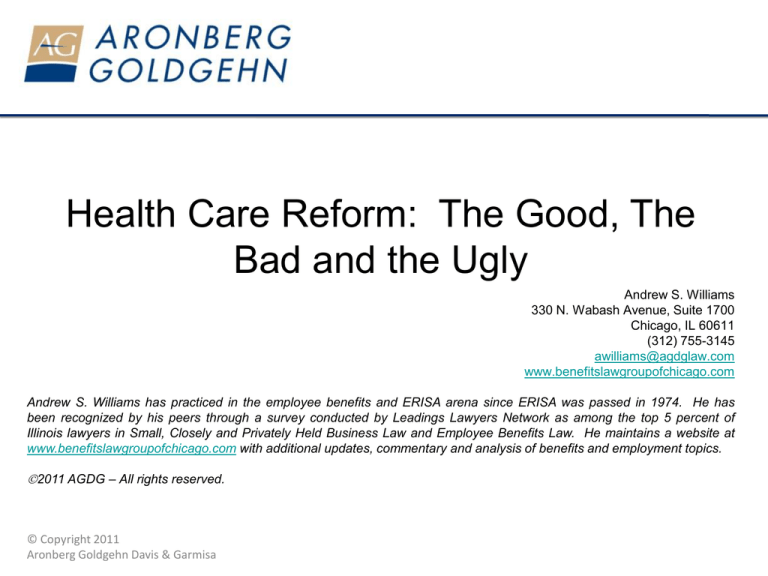
Health Care Reform: The Good, The
Bad and the Ugly
Andrew S. Williams
330 N. Wabash Avenue, Suite 1700
Chicago, IL 60611
(312) 755-3145
awilliams@agdglaw.com
www.benefitslawgroupofchicago.com
Andrew S. Williams has practiced in the employee benefits and ERISA arena since ERISA was passed in 1974. He has
been recognized by his peers through a survey conducted by Leadings Lawyers Network as among the top 5 percent of
Illinois lawyers in Small, Closely and Privately Held Business Law and Employee Benefits Law. He maintains a website at
www.benefitslawgroupofchicago.com with additional updates, commentary and analysis of benefits and employment topics.
2011 AGDG – All rights reserved.
© Copyright 2011
Aronberg Goldgehn Davis & Garmisa
PPACA will impose:
• expanded access
• mandated benefits
• compliance responsibilities
• corresponding costs increases
© Copyright 2011
Aronberg Goldgehn Davis & Garmisa
2
Andrew S. WIliams
awilliams@agdglaw.com
Who Are The Uninsured?
• Those who do not have access to
employer-provided coverage, including the
unemployed
© Copyright 2011
Aronberg Goldgehn Davis & Garmisa
3
Andrew S. WIliams
awilliams@agdglaw.com
• Those with family incomes over $75,000
who elect not to be covered
© Copyright 2011
Aronberg Goldgehn Davis & Garmisa
4
Andrew S. WIliams
awilliams@agdglaw.com
• Those who are already eligible for
government health coverage and have not
enrolled
© Copyright 2011
Aronberg Goldgehn Davis & Garmisa
5
Andrew S. WIliams
awilliams@agdglaw.com
• Undocumented workers
© Copyright 2011
Aronberg Goldgehn Davis & Garmisa
6
Andrew S. WIliams
awilliams@agdglaw.com
PPACA is intended to help millions more
Americans obtain health insurance
coverage, but its requirements will affect
almost all of us, beginning now
© Copyright 2011
Aronberg Goldgehn Davis & Garmisa
7
Andrew S. WIliams
awilliams@agdglaw.com
Consider the following overview of only the
most significant changes:
© Copyright 2011
Aronberg Goldgehn Davis & Garmisa
8
Andrew S. WIliams
awilliams@agdglaw.com
THE GOOD
(current requirements only)
© Copyright 2011
Aronberg Goldgehn Davis & Garmisa
9
Andrew S. WIliams
awilliams@agdglaw.com
• Subject plans must cover otherwise
eligible children under age 19 regardless
of any pre-existing conditions
© Copyright 2011
Aronberg Goldgehn Davis & Garmisa
10
Andrew S. WIliams
awilliams@agdglaw.com
• PPACA prohibits cancellation of individual
policies because of faulty or incomplete
information disclosed on application forms
(there’s an exception for fraud)
© Copyright 2011
Aronberg Goldgehn Davis & Garmisa
11
Andrew S. WIliams
awilliams@agdglaw.com
• Lifetime coverage maximums are
abolished
© Copyright 2011
Aronberg Goldgehn Davis & Garmisa
12
Andrew S. WIliams
awilliams@agdglaw.com
• Coverage of adult children up to age 26 is
required under a parent’s group health
plan, regardless of their student,
dependency or marital status
© Copyright 2011
Aronberg Goldgehn Davis & Garmisa
13
Andrew S. WIliams
awilliams@agdglaw.com
• Insurers must rebate a portion of
premiums to policy holders if more than 15
percent of premium revenue (20 percent
for small group and individual plans) is
expended on costs other than payment of
medical claims
© Copyright 2011
Aronberg Goldgehn Davis & Garmisa
14
Andrew S. WIliams
awilliams@agdglaw.com
• Except for “grandfathered” plans, group health
coverage will also have to provide:
© Copyright 2011
Aronberg Goldgehn Davis & Garmisa
15
Andrew S. WIliams
awilliams@agdglaw.com
• first dollar care for designated diagnostic
procedures (immunizations, blood
pressure checks, mammograms and colon
cancer screenings)
© Copyright 2011
Aronberg Goldgehn Davis & Garmisa
16
Andrew S. WIliams
awilliams@agdglaw.com
• emergency medical services must be
available without pre-authorization or outof-network surcharges
© Copyright 2011
Aronberg Goldgehn Davis & Garmisa
17
Andrew S. WIliams
awilliams@agdglaw.com
• participants must be allowed to choose a
primary care provider in plans which
require one
© Copyright 2011
Aronberg Goldgehn Davis & Garmisa
18
Andrew S. WIliams
awilliams@agdglaw.com
• Additional Medicare benefits include lower
Part D prescription drug costs, “free”
annual physical exams and certain “free”
preventative services
© Copyright 2011
Aronberg Goldgehn Davis & Garmisa
19
Andrew S. WIliams
awilliams@agdglaw.com
Miscellaneous other perks include:
• a health care tax credit for employers with
fewer than 25 employees with an average
wage of less than $50,000 per year, and
• an exemption from the penalties for failure to
provide employee health coverage for
employers with 49 or fewer employees
© Copyright 2011
Aronberg Goldgehn Davis & Garmisa
20
Andrew S. WIliams
awilliams@agdglaw.com
THE BAD
© Copyright 2011
Aronberg Goldgehn Davis & Garmisa
21
Andrew S. WIliams
awilliams@agdglaw.com
Coverage mandates and other expansions
of coverage will cost additional premium
dollars, estimated at between an extra 1 to
9 percent of premium expense this year.
That’s on top of premium increases
reflecting the general upward trend of
medical costs.
© Copyright 2011
Aronberg Goldgehn Davis & Garmisa
22
Andrew S. WIliams
awilliams@agdglaw.com
Extra taxes, incentives and other revenue
raising rules affect individuals and a wide
variety of industries ranging from tanning
salons to bio fuel producers
© Copyright 2011
Aronberg Goldgehn Davis & Garmisa
23
Andrew S. WIliams
awilliams@agdglaw.com
Individual Mandate Excise Tax: Starting in 2014, anyone not
buying “qualifying” health insurance must pay an income surtax
according to the higher of the following:
1 Adult
2 Adults
3+ Adults
2014
1% AGI/$95
1% AGI/$190
1% AGI/$285
2015
2% AGI/$325
2% AGI/$650
2% AGI/$975
2.5% AGI/$1390
2.5% AGI/$2085
2016+ 2.5% AGI/$695
© Copyright 2011
Aronberg Goldgehn Davis & Garmisa
24
Andrew S. WIliams
awilliams@agdglaw.com
Employer Mandate Tax (Jan. 2014): If an employer
does not offer health coverage, and at least one
employee qualifies for a health tax credit, the employer
must pay an additional non-deductible tax of $2000 for
all full-time employees. This provision applies to all
employers with 50 or more employees. If any employee
actually receives coverage through the exchange, the
penalty on the employer for that employee rises to
$3000. If the employer requires a waiting period to enroll
in coverage of 30-60 days, there is a $400 tax per
employee ($600 if the period is 60 days or longer).
© Copyright 2011
Aronberg Goldgehn Davis & Garmisa
25
Andrew S. WIliams
awilliams@agdglaw.com
Surtax on Investment Income (Jan. 2013): This
increase involves the creation of a new, 3.8 percent
surtax on investment income earned in households
making at least $250,000 ($200,000 single)
© Copyright 2011
Aronberg Goldgehn Davis & Garmisa
26
Andrew S. WIliams
awilliams@agdglaw.com
Excise Tax on Comprehensive Health Insurance
Plans (Jan. 2018): Starting in 2018, new 40 percent
excise tax on “Cadillac” health insurance plans (plans
charging more than $10,200 single/$27,500 family
annual premiums)
© Copyright 2011
Aronberg Goldgehn Davis & Garmisa
27
Andrew S. WIliams
awilliams@agdglaw.com
Hike in Medicare Payroll Tax (Jan. 2013): Withholding
tax for higher incomes (over $200,000 individual,
$250,000 married) increases from 1.45% to 2.35%
(employee portion)
© Copyright 2011
Aronberg Goldgehn Davis & Garmisa
28
Andrew S. WIliams
awilliams@agdglaw.com
Medicine Cabinet “Tax” (Jan. 2011): Americans no
longer able to use health savings account (HSA), flexible
spending account (FSA), or health reimbursement (HRA)
pre-tax dollars to purchase non-prescription, over-thecounter medicines (except insulin)
© Copyright 2011
Aronberg Goldgehn Davis & Garmisa
29
Andrew S. WIliams
awilliams@agdglaw.com
HSA Withdrawal Tax Hike (Jan. 2011): Increases
additional tax on non-medical early withdrawals from an
HSA from 10 to 20 percent
© Copyright 2011
Aronberg Goldgehn Davis & Garmisa
30
Andrew S. WIliams
awilliams@agdglaw.com
Flexible Spending Account Cap – a/k/a “Special
Needs Kids Tax” (Jan. 2013): Imposes cap of $2500
(Indexed to inflation after 2013) on FSAs (now unlimited)
© Copyright 2011
Aronberg Goldgehn Davis & Garmisa
31
Andrew S. WIliams
awilliams@agdglaw.com
Tax on Medical Device Manufacturers (Jan. 2013): This
law imposes a new 2.3% excise tax on medical devices
© Copyright 2011
Aronberg Goldgehn Davis & Garmisa
32
Andrew S. WIliams
awilliams@agdglaw.com
Raise “Threshhold” for Medical Itemized Deduction
from 7.5% to 10% of AGI (Jan. 2013)
© Copyright 2011
Aronberg Goldgehn Davis & Garmisa
33
Andrew S. WIliams
awilliams@agdglaw.com
Tax on Indoor Tanning Services (July 1, 2010): New
10 percent excise tax on indoor tanning salons
© Copyright 2011
Aronberg Goldgehn Davis & Garmisa
34
Andrew S. WIliams
awilliams@agdglaw.com
• Tax on Drug Companies (Jan. 2010): $2.3 billion
annual tax on the industry imposed relative to share of
sales made that year
© Copyright 2011
Aronberg Goldgehn Davis & Garmisa
35
Andrew S. WIliams
awilliams@agdglaw.com
• States are responsible for additional
Medicare and Medicaid costs
• Medicare premiums for Part B and Part D
coverage also will increase in 2011 for
higher income recipients
© Copyright 2011
Aronberg Goldgehn Davis & Garmisa
36
Andrew S. WIliams
awilliams@agdglaw.com
Non-grandfathered, self-insured plans may
have to engage independent claims review
organizations (either directly or through
their third party administrators) in order to
satisfy PPACA’s new external claims
review requirements
© Copyright 2011
Aronberg Goldgehn Davis & Garmisa
37
Andrew S. WIliams
awilliams@agdglaw.com
Non-grandfathered fully insured plans will have
to comply with nondiscrimination rules that
previously applied only to self-insured plans.
Failure to comply in an insured plan exposes the
employer to an excise tax of $100 per day per
participant, not just the taxation of benefits to
highly compensated employees (enforcement of
this provision has been postponed indefinitely)
© Copyright 2011
Aronberg Goldgehn Davis & Garmisa
38
Andrew S. WIliams
awilliams@agdglaw.com
THE UGLY
Click To Play : http://www.youtube.com/watch?v=1LRcLMScEqo
© Copyright 2011
Aronberg Goldgehn Davis & Garmisa
39
Andrew S. WIliams
awilliams@agdglaw.com
PPACA reforms technically allow employers to
keep their group health plans as they existed on
March 23, 2010 if they meet certain
requirements for “grandfathered” plans
© Copyright 2011
Aronberg Goldgehn Davis & Garmisa
40
Andrew S. WIliams
awilliams@agdglaw.com
Premium changes are not taken into
account when determining whether or not
a plan is grandfathered
© Copyright 2011
Aronberg Goldgehn Davis & Garmisa
41
Andrew S. WIliams
awilliams@agdglaw.com
Plans will lose their grandfathered status if
they choose to make significant changes
that reduce benefits or increase costs to
participants. Examples of prohibited
changes include:
© Copyright 2011
Aronberg Goldgehn Davis & Garmisa
42
Andrew S. WIliams
awilliams@agdglaw.com
• A Significant Cut or Reduction in Benefits.
For example, if a plan decides to no longer
cover care for people with diabetes, cystic
fibrosis or HIV/AIDS
© Copyright 2011
Aronberg Goldgehn Davis & Garmisa
43
Andrew S. WIliams
awilliams@agdglaw.com
• Raising Co-Insurance Charges. Typically,
co-insurance requires a patient to pay a
fixed percentage of a charge (for example,
20% of a hospital bill). Grandfathered
plans cannot increase this percentage.
© Copyright 2011
Aronberg Goldgehn Davis & Garmisa
44
Andrew S. WIliams
awilliams@agdglaw.com
• Significantly Raising Co-Payment
Charges. Compared with the copayments in
effect on March 23, 2010, grandfathered plans
will be able to increase those co-pays by no
more than the greater of $5 (adjusted annually
for medical inflation) or a percentage equal to
medical inflation plus 15 percentage points. For
example, if a plan raises its copayment from $30
to $50 over the next 2 years, it will lose its
grandfathered status.
© Copyright 2011
Aronberg Goldgehn Davis & Garmisa
45
Andrew S. WIliams
awilliams@agdglaw.com
• Significantly Raising Deductibles.
Compared with the deductible required as
of March 23, 2010, grandfathered plans
can only increase these deductibles by a
percentage equal to medical inflation plus
15 percentage points.
© Copyright 2011
Aronberg Goldgehn Davis & Garmisa
46
Andrew S. WIliams
awilliams@agdglaw.com
• Significantly Lowering Employer
Contributions. Grandfathered plans
cannot decrease the percent of premiums
the employer pays by more than 5
percentage points.
© Copyright 2011
Aronberg Goldgehn Davis & Garmisa
47
Andrew S. WIliams
awilliams@agdglaw.com
• Adding or Reducing an Annual Limit on
What the Insurer Pays
© Copyright 2011
Aronberg Goldgehn Davis & Garmisa
48
Andrew S. WIliams
awilliams@agdglaw.com
For insured plans, insurance companies
probably will impose plan changes without
regard to grandfathered status
© Copyright 2011
Aronberg Goldgehn Davis & Garmisa
49
Andrew S. WIliams
awilliams@agdglaw.com
Accordingly, by government estimates,
about 80 percent of existing small
business plans will be unable to maintain
their grandfathered plan status – those
employers will not be able to keep their
current plan if they like it
© Copyright 2011
Aronberg Goldgehn Davis & Garmisa
50
Andrew S. WIliams
awilliams@agdglaw.com
What To Do?
© Copyright 2011
Aronberg Goldgehn Davis & Garmisa
51
Andrew S. WIliams
awilliams@agdglaw.com
Because insurers’ gross margin on policy
premiums are now limited to 15 percent
(20 percent for small group plans and
individual policies), broker commissions
are likely to be reduced or eliminated – so
commission fee brokers may be a thing of
the past.
© Copyright 2011
Aronberg Goldgehn Davis & Garmisa
52
Andrew S. WIliams
awilliams@agdglaw.com
Consider plan design changes to shift high
risk employees to the state insurance
exchanges
© Copyright 2011
Aronberg Goldgehn Davis & Garmisa
53
Andrew S. WIliams
awilliams@agdglaw.com
Anti-discrimination rules for insured group
health plans require careful planning while
definitive guidance is being prepared –
© Copyright 2011
Aronberg Goldgehn Davis & Garmisa
54
Andrew S. WIliams
awilliams@agdglaw.com
• Don’t continue a two-tiered plan
• Be careful with any executive agreement
that provides additional health benefits,
including subsidized COBRA
© Copyright 2011
Aronberg Goldgehn Davis & Garmisa
55
Andrew S. WIliams
awilliams@agdglaw.com
Consider personal tax strategies to
minimize exposure to the 3.8 percent
health care surtax or investment income
effective starting in 2013
© Copyright 2011
Aronberg Goldgehn Davis & Garmisa
56
Andrew S. WIliams
awilliams@agdglaw.com
Harvest capital gains in 2012
© Copyright 2011
Aronberg Goldgehn Davis & Garmisa
57
Andrew S. WIliams
awilliams@agdglaw.com
Convert conventional IRAs to Roth IRAs
© Copyright 2011
Aronberg Goldgehn Davis & Garmisa
58
Andrew S. WIliams
awilliams@agdglaw.com
Consider tax-exempt or tax-deferred
investments (municipal bonds, taxdeferred annuities, life insurance, real
estate, and charitable remainder trusts)
© Copyright 2011
Aronberg Goldgehn Davis & Garmisa
59
Andrew S. WIliams
awilliams@agdglaw.com
Discontinue your employer provided group
health plan
© Copyright 2011
Aronberg Goldgehn Davis & Garmisa
60
Andrew S. WIliams
awilliams@agdglaw.com
The above material is intended for general information and promotional
purposes, and should not be relied on or construed as professional advice.
Under the Illinois Rules of Professional Conduct, the above information may
be considered advertising material. The submission of this information is
not intended to create, and receipt of it does not create, a lawyer-client
relationship
© Copyright 2011
Aronberg Goldgehn Davis & Garmisa
61
Andrew S. WIliams
awilliams@agdglaw.com
Andrew S. Williams
(312) 755-3145
awilliams@agdglaw.com
www.BenefitsLawGroupofChicago.com
Aronberg Goldgehn Davis & Garmisa
330 N. Wabash Avenue
Suite 1700
Chicago, IL 60611
© Copyright 2011
Aronberg Goldgehn Davis & Garmisa
62
Andrew S. WIliams
awilliams@agdglaw.com







